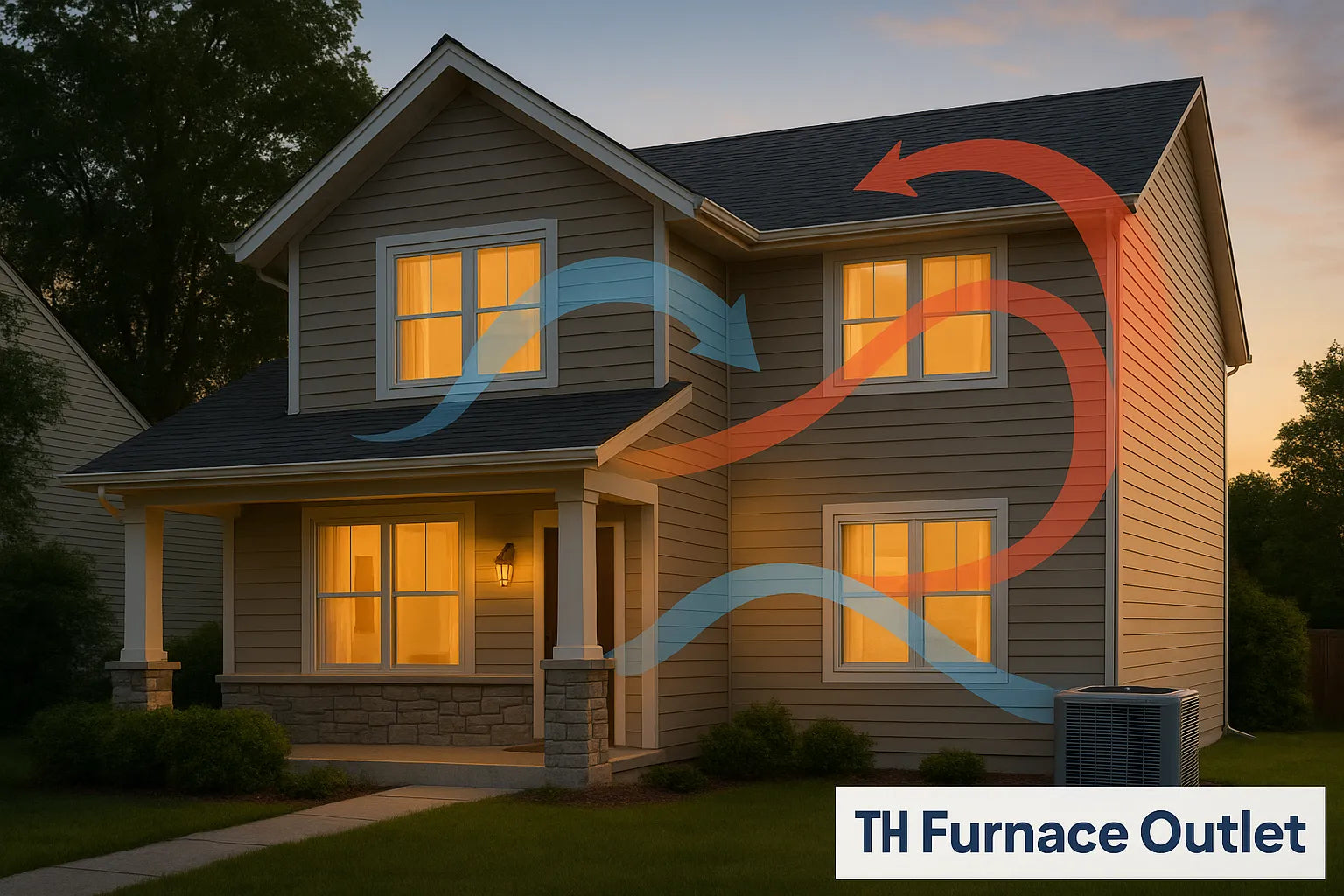What SEER2 Really Measures and What It Doesn’t
SEER2 tests equipment under steady, moderate conditions that assume a properly sized load. Once an oversized system hits the thermostat set-point in a flash, it never reaches those steady-state lab conditions again. Each rapid start-up draws inrush amperage, spikes demand, and drags average efficiency far below the yellow label. Bottom line:
SEER2 is a ceiling, not a guarantee. To get close to that ceiling you need correct load calculations not just a high number on the spec sheet. See our detailed SEER2 equipment lineup for right-sized options.
The Physics of Short Cycling
When a 4-ton condenser is stuffed onto a 2-ton heat load, it cools the coil and your house so fast that it cuts off within minutes. This “short cycle” repeats 6–10 times an hour versus the 2–3 cycles a matched system runs. Each start dumps extra BTUs into the compressor windings, raises amperage, and steals longevity.
A data-logger strapped to the contactor shows duty cycles dropping below 30 %, well under the 60 % sweet spot manufacturers design around. Frequent hard starts also defeat soft-start kits and add heat to the service disconnect check yours on next maintenance call.
Humidity: The Hidden Comfort Killer
Cooling is only half the comfort puzzle; moisture removal matters just as much. Coils need 8–12 minutes of continuous run time to condense significant water. An oversized unit that shuts off at minute five leaves latent heat behind, so the air feels clammy even at 72 °F. High indoor RH invites mold around supply registers and forces occupants to lower the thermostat even further—erasing projected savings. For tight humidity control, many techs spec a slightly lower ton-per-square-foot ratio and add a high-SEER2 variable-speed air handler such as those in our air-handler collection.
System Lifespan and Oversize Stress
Compressors live or die by start counts and run-time temperature swings. Oversizing ratchets both upward, burning oil, pitting contact points, and cracking scrolls. Field data from warranty files shows oversized compressors failing 20-30 % earlier than properly matched ones. Finding slugged refrigerant in the sump? Short cycles didn’t give the crankcase heater time to boil it out. Pro Tip: If you inherit an existing oversize unit, install a hard-start kit and crankcase heater while you plan a right-size replacement—quick wins that cost far less than a mid-season compressor swap.
Real-World Cost Math: When High SEER2 Underperforms
Energy models assume 100 % load match. In practice, a 17.2 SEER2 oversize system can land closer to 13–14 SEER2 equivalent, wiping out 20 % of the advertised savings. Add premature failures, comfort callbacks, and dehumidifier add-ons, and total cost of ownership balloons. If you’re chasing lower bills, investing in proper Manual J and Manual S calculations beats upsizing hardware every time. Start with our free sizing guide to ballpark loads before you buy.
Load Calculation 101: How Pros Right-Size
Pros lean on Manual J (heat-gain/heat-loss analysis) followed by Manual S (equipment selection). Critical inputs include:
-
Envelope tightness & R-values
-
Window SHGC & orientation
-
Duct location & leakage
-
Occupancy & internal gains
A cloud-based tool processes these variables into sensible and latent loads per zone. The chosen unit should meet 95–105 % of design load in cooling mode—never 120 %+. Need a hand? Snap photos of your layout and use our HVAC Quote by Photo service for a pro review.
Field Example: Fixing an Oversized 3-Ton in a 1,600 Sq Ft Home
A homeowner in humid coastal Texas swapped a builder-grade 3-ton (oversized by 0.75 ton) for a 2-ton, 16.2 SEER2 R-32 heat pump from our R-32 packaged systems. Results after one cooling season:
-
Cycle Length: 14 minutes vs. 6 minutes
-
Indoor RH: 47 % vs. 60 %
-
kWh Drop: -22 % summer usage
-
Compressor Starts: 8 per hour → 3 per hour
Comfort complaints disappeared, and total savings offset the equipment cost in 2.8 years proof that tonnage discipline beats spec-sheet bragging rights.
Design Considerations for Variable-Speed and Staged Equipment
Variable-speed compressors and multi-stage furnaces can tolerate slight oversizing, but abuse is still costly. Stages or inverter ramps down capacity only within designed ranges; exceed them and the unit still short cycles. Match minimum capacity output to latent load first, then check total sensible load. A 3-ton inverter that modulates down to 30 % (≈0.9 ton) is safer than a two-stage inverter that never drops below 2 tons. Explore our full ductless mini-split line for inverter options with turn-down ratios up to 5:1.
Tools & Accessories That Support Correct Sizing
Even the best-sized system can stumble without proper installation. Stock your truck with:
-
Accurate static pressure gauges for duct verification
-
Smart thermostats with cycle-rate limits
-
Quality line-sets & flare kits—find them here
-
Commissioning sensors (temperature, RH, watt-draw) for post-install verification
Using these accessories during start-up helps lock in the SEER2 performance you sold the customer and documents baseline numbers for warranty protection.
Commissioning Checklist to Protect Your SEER2 Investment
Before you hand over the keys, confirm:
-
Measured CFM matches Manual D design
-
Superheat/subcool fall within OEM charts
-
Delta-T across coil is 18–22 °F
-
Static pressure ≤ design spec (often 0.5 in. w.c.)
-
Thermostat cycle rate set to 2–3/hr for heat pumps
Document these in a cloud log and share with the homeowner via our Help Center. A tight commissioning sheet is the cheapest insurance against callbacks and it cements the reputation of both installer and brand.
Ready to Dial-In Your SEER2 Savings?
Still weighing tonnage options or fighting humidity in a “too-big” system? Talk to a sizing specialist today. We’ll run a quick Manual J, recommend right-sized high-SEER2 equipment, and ship it factory-direct often the same day. Contact The Furnace Outlet or use our no-obligation Quote by Photo to make your next install the one that really pays off.







